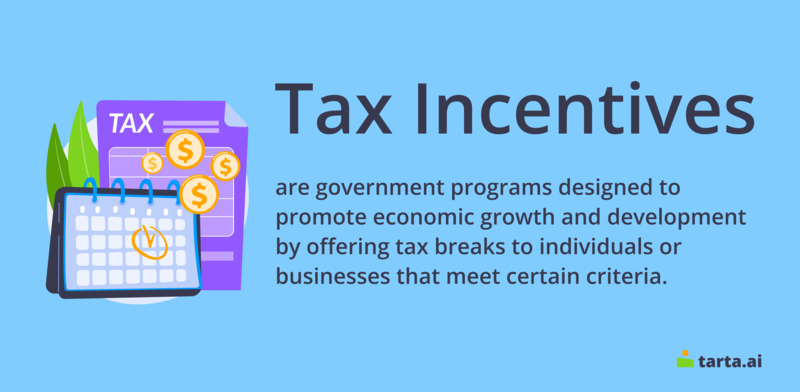Understanding Tax Incentives: Forms, Benefits, and Challenges for Economic Growth and Development

These incentives can take many forms, including tax credits, deductions, exemptions, and abatements. They are often used to encourage investment, job creation, and innovation.
Types of Tax Incentives
Tax credits: Tax credits are a type of tax incentive that allow taxpayers to reduce their tax liability by a specific amount for each dollar spent on a particular activity or investment. For example, businesses that invest in renewable energy may be eligible for a tax credit that reduces their tax liability. Tax credits can be refundable or non-refundable, depending on the specific program.
The historic climate law extended and amended a $7,500 tax credit for plug-in electric and fuel cell vehicles.
Tax deductions: Tax deductions allow taxpayers to reduce their taxable income by subtracting specific expenses from their income before calculating their tax liability. For example, businesses may be able to deduct expenses related to research and development or investment in equipment or facilities.
Tax exemptions: Tax exemptions exclude certain types of income or activities from taxation. For example, some states offer tax exemptions for renewable energy investments or agricultural activities.
Tax holidays: Tax holidays are temporary periods during which taxpayers are exempt from paying certain taxes. For example, some states offer tax holidays for back-to-school shopping or hurricane preparedness.
Tax deferrals: Tax deferrals allow taxpayers to delay paying taxes on income or activities until a later date. For example, businesses may be able to defer paying taxes on income earned from foreign investments until that income is repatriated to the United States.
Tax abatements: Tax abatements are a type of tax incentive where the government reduces or eliminates a company’s tax liability for a certain period of time. This is often used to encourage businesses to locate in specific areas or invest in certain types of projects.
Benefits and Challenges of Tax Incentives
While tax incentives are widely used by governments around the world to promote economic growth, their effectiveness and fairness have been debated. One criticism of tax incentives is that they can be costly for taxpayers, as they reduce government revenue and potentially increase the tax burden on other taxpayers. Additionally, there is often little transparency and accountability around the selection and implementation of tax incentives, which can lead to political favoritism and unfair advantages for certain industries or companies.
Moreover, tax incentives can be difficult to administer and enforce, which can lead to unintended consequences or abuse. For example, some companies may artificially inflate their investments or activities to qualify for tax incentives, which can undermine the intended economic benefits of the incentives. Similarly, some industries may be better positioned to take advantage of tax incentives than others, which can exacerbate existing inequalities and distort market competition.
Despite these challenges, tax incentives remain a popular tool for economic development. To address some of the criticisms and challenges, governments are increasingly implementing more targeted and transparent tax incentive programs. This includes conducting regular evaluations of the effectiveness and efficiency of tax incentives, as well as engaging stakeholders in the design and implementation of tax incentives.
In conclusion, while tax incentives can have a significant impact on economic growth and development, they are not without their challenges and criticisms. To ensure that tax incentives are effective and fair, it is important to carefully evaluate and monitor their use, increase transparency and accountability, and implement more targeted and equitable tax incentive programs.
- Tax incentives are government programs designed to promote economic growth and development.
- Tax incentives can take many forms, including tax credits, deductions, exemptions, tax holidays, tax deferrals, and tax abatements.
- Tax incentives can be costly for taxpayers and can potentially create unfair advantages for certain industries or companies.
- Tax incentives can also be difficult to administer and enforce, leading to unintended consequences or abuse.
- Governments are increasingly implementing more targeted and transparent tax incentive programs to address criticisms and challenges.
- To ensure that tax incentives are effective and fair, it is important to carefully evaluate and monitor their use, increase transparency and accountability, and implement more targeted and equitable tax incentive programs.
FAQ
Are tax incentives guaranteed?
No, tax incentives are not guaranteed. Eligibility and benefits may be subject to change based on legislative or regulatory changes, and there may be limitations or restrictions on the amount of benefits that can be received.
What is the difference between tax credits and tax deductions?
Tax credits allow taxpayers to directly reduce their tax liability by a specific amount, while tax deductions reduce taxable income, which can indirectly reduce tax liability.
Can I claim multiple tax incentives?
Yes, it is possible to claim multiple tax incentives as long as you meet the eligibility requirements for each program. However, it's important to carefully consider the costs and requirements associated with each program and weigh them against the potential benefits.
How do I apply for tax incentives?
The application process for tax incentives also varies depending on the program. Some incentives may require a formal application process with documentation and proof of eligibility, while others may be automatic.
Who is eligible for tax incentives?
Some incentives may be available to all taxpayers, while others may be targeted at specific industries or types of businesses.